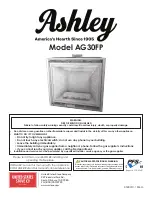
38
8-AIR INLETS
FLUE CONNECTION
Please bear in mind that:
•
All external air inlets must have a closing damper that can be controlled from the outside, along with an insect screen.
•
The air inlet section is a net value, so you need to consider the area of any other elements (netting, etc.)
•
Periodically clean the filters or netting to ensure the air can pass through
•
Do not, for any reason, obstruct the air inlets if the closed fireplace or ventilation kit is running.
CONNECTION TO THE FLUE
We recommend connecting the closed fireplace to the flue using aluminium-plated steel pipes and bends that are able to withstand the
high temperatures of that section and smoke corrosion. These connections are available on request in various sizes (see our price list) and
they simplify installation as they are assembled by fitting one inside the other.
Any increase in the cross-section of the connection must be set up directly above the hood of the closed fireplace and
not along the flue.
When installation is complete, it is compulsory to insulate the smoke fittings with ceramic fibre padding or any
material that is resistant to at least 600°C.
CLADDING AND COUNTER-HOOD ASSEMBLY
READ THE “OPERATION TEST” CHAPTER BEFORE STARTING ANY CLOSED FIREPLACE CLADDING OPERATION
The closed fireplace and parts of the cladding must be fastened to each other
WITHOUT TOUCHING THE STEEL STRUCTURE
to avoid transmitting heat to the marble and/or stone and to allow for normal thermal dilation; pay attention to wood finishes like beams
or shelves.
It is recommended to construct the counter-hood in fire-retardant plasterboard,
15/20 mm thick with self-supported
galvanized profile frame in order not to bear on the cladding components (wooden beams or marble architraves) which do not have a load
bearing structure and to be able to operate easily in the event of faults and/or future maintenance.
Dry-assemble the hearth of the
cladding leaving a 1 cm gap between closed fireplace and hearth to perform insulation.
CLOSED FIREPLACE INSULATION
The closed fireplace always needs to be separate from the adjacent walls and ceiling.
If necessary, use insulating materials to insulate the walls touching the closed fireplace, if they run the risk of getting damaged or even
catching fire (wood walls, plasterboard, etc...).
















































